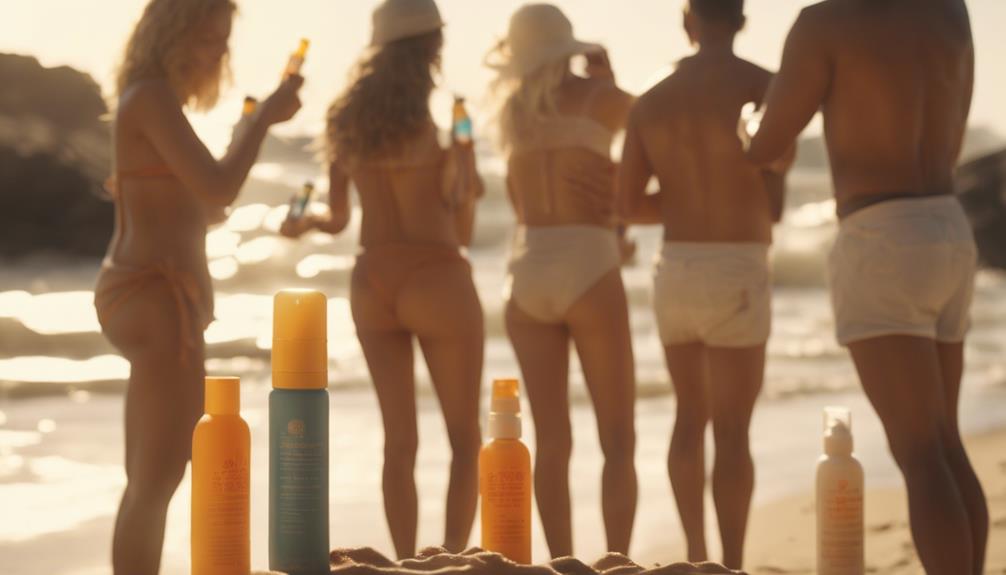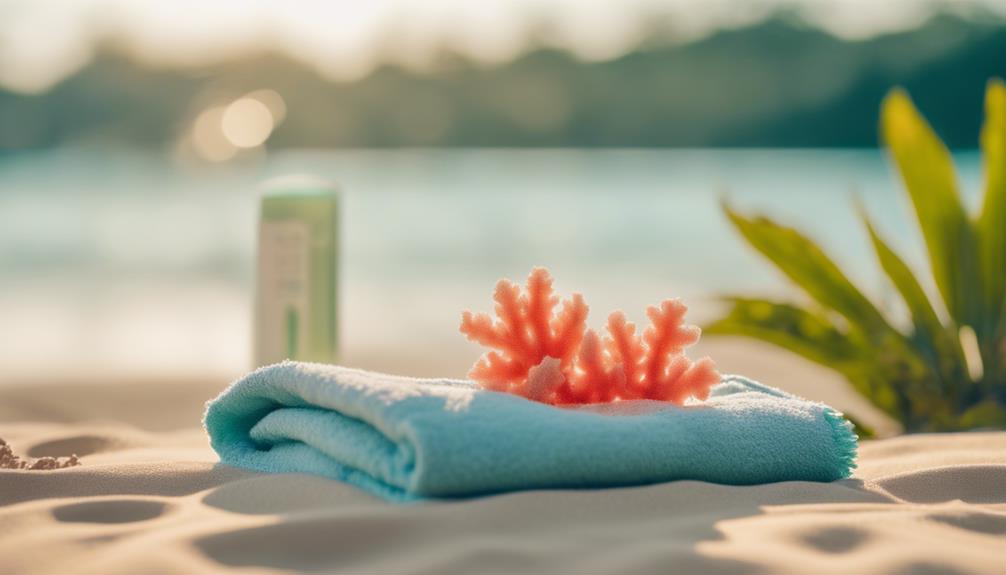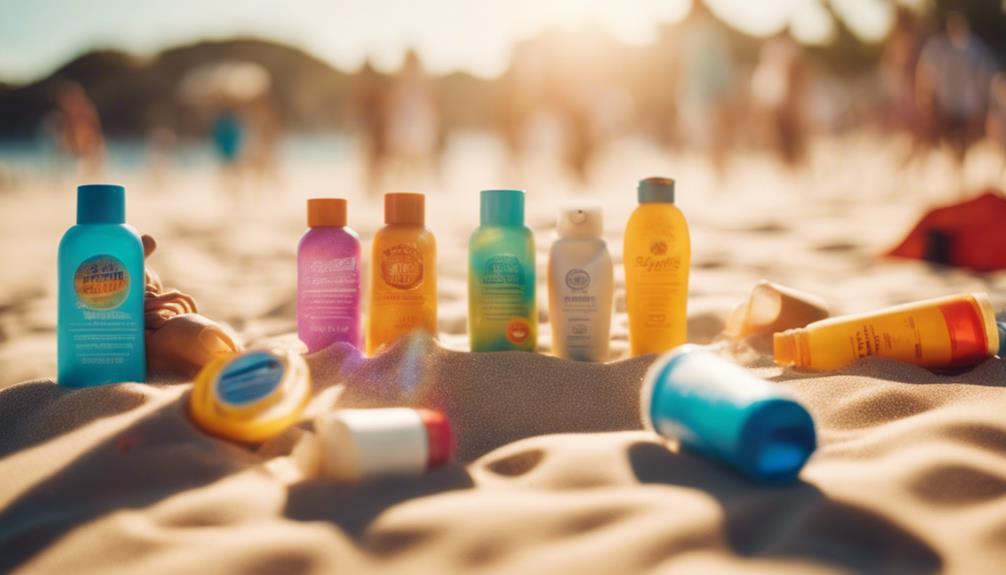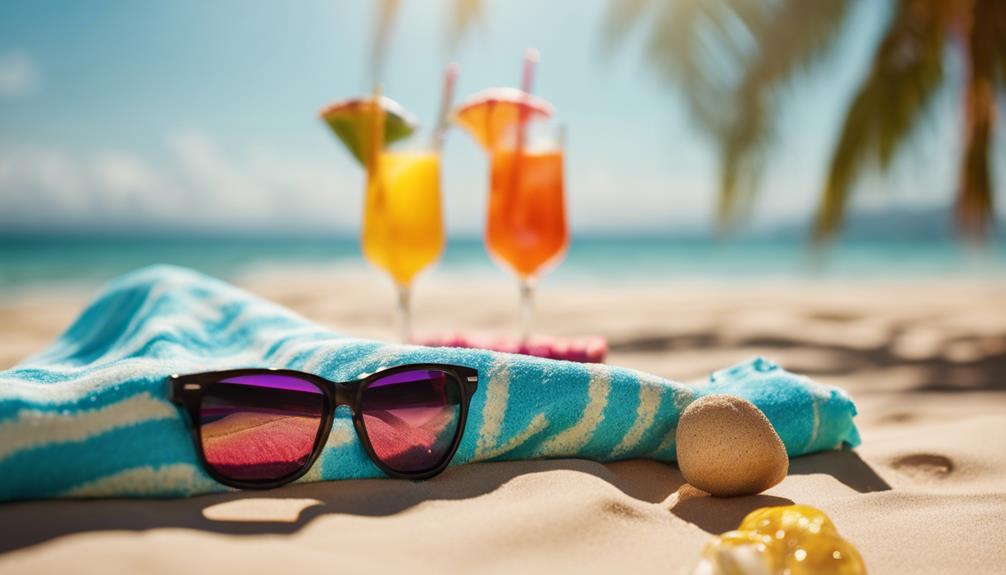To glow safely under the sun, you gotta pick the right tanning sunscreen! Look for one with at least SPF 30 to fend off those nasty UV rays, and don't forget to reapply every two hours—yes, even while you're chillin' at the beach! If you're dealing with dry skin, go for moisturizing options; folks with oily skin should stick to lightweight, oil-free sunscreens. Oh, and how about some reef-safe options to keep those ocean friends safe? Remember, the goal is to shine without frying your skin. Stick around, and you'll find some top product suggestions to get that perfect tan!
Key Takeaways
- Choose tanning sunscreens with SPF 30 or higher for effective protection against UVB rays while promoting a golden glow.
- Look for products that are both moisturizing and oil-free to cater to your skin type and enhance hydration.
- Opt for reef-safe options to protect marine ecosystems while achieving your desired tan without harmful chemicals.
- Apply sunscreen generously, at least 15 minutes before sun exposure, and reapply every two hours for consistent protection.
Importance of SPF
Understanding the importance of SPF in sunscreens is essential for effectively protecting your skin from harmful UV rays.
Think about it: you wouldn't drive without a seatbelt, right? Well, your skin needs protection too!
SPF measures how well a sunscreen guards against those pesky UVB rays, which are the main culprits behind sunburn. A higher SPF means longer-lasting protection, so aim for SPF 30 or higher.
Plus, don't forget about broad spectrum protection—it keeps you safe from both UVA and UVB rays!
Regular use can lower your risk of skin cancer and premature aging. Just remember to reapply every two hours.
Selecting the Right Formula

Choosing the right sunscreen formula is essential for ensuring your skin gets the protection it needs based on your specific skin type.
If you've got dry skin, look for something moisturizing, like those with oils.
For oily or acne-prone skin, lightweight and oil-free options are your best buddies.
Got sensitive skin? You'll want hypoallergenic and fragrance-free formulas—trust me, your skin will thank you!
And if you're rocking combination skin, you might need different products for different spots—talk about a skincare juggling act!
Always do a patch test to dodge any unwanted reactions.
Effective Application Techniques

Applying sunscreen correctly is just as important as selecting the right formula, ensuring you get the maximum protection for your skin type.
Start by slathering on enough sunscreen—about an ounce should cover your whole body. Yes, that's a lot, but think of it as giving your skin a cozy blanket!
Apply it at least 15 minutes before heading outside to let it soak in. Don't forget those tricky spots, like behind your ears or on your feet.
And remember, reapply every two hours, or right after diving into the pool or sweating like you just ran a marathon.
Trust me, nobody wants to look like a lobster! So, have fun, stay safe, and keep that glow going!
Environmental Impact of Sunscreens

Sunscreens can considerably impact marine ecosystems, especially when they contain harmful chemicals that wash off into the water. Ever heard of coral reefs getting sick? Yup, some ingredients in sunscreens can do that!
You mightn't think about it while slathering on that SPF, but chemicals like oxybenzone and octinoxate can harm sea life. So, what can you do? Stick to reef-safe options! These sunscreens are designed to protect your skin without sending marine critters into a panic.
Plus, choosing biodegradable packaging helps keep our beaches clean. It's a win-win! Remember, your sunscreen should protect not just you, but the environment too.
Natural Ingredients Benefits

Natural ingredients in sunscreens not only provide skin benefits but also enhance your overall sun protection experience.
Ever tried slathering coconut oil on your skin? It's super moisturizing!
Plus, ingredients like Kakadu Plum are packed with Vitamin C, which means your skin gets a boost while you soak up the sun.
And who doesn't love the soothing touch of aloe vera? It's like a mini spa treatment right on the beach!
With natural ingredients, you're not just protecting yourself from harmful rays; you're also treating your skin to some TLC.
So, ditch the chemical-laden products and embrace the power of nature.
Your skin will thank you, and you might even feel like a glowing sun goddess! ��
Recommended Sunscreen Products

Here are some top-rated sunscreen products that cater to various skin types and preferences, ensuring you stay protected while enjoying the sun.
If you're all about hydration, check out Australian Gold SPF 30 Spray Gel; it's packed with oils that feel silky smooth.
For those who prefer a classic, Coppertone SPF 15 has been a reliable choice for ages—seriously, it's practically a sunblock legend!
Want something vegan? Sun Bum Moisturizing Tanning Oil is your go-to, plus it's reef-safe!
And if you love a tropical vibe, Hawaiian Tropic SPF 15 smells like a beach vacation!
Understanding Water Resistance

When enjoying the sun, understanding water resistance in your sunscreen can make a big difference in maintaining effective protection during activities like swimming or sweating.
You know how annoying it is to apply sunscreen, only to splash around and feel it wash away? Water-resistant formulas can last up to 80 minutes, which is great, but don't forget—this doesn't mean you can skip reapplying!
After towel drying or a long swim, slather on more sunscreen to keep your skin safe.
Also, remember, water resistance isn't a free pass to skip sunscreen altogether.
Trends in Consumer Preferences

Consumers today are increasingly leaning towards vegan and cruelty-free sunscreen options that align with their values and lifestyle choices. You might be wondering why everyone's buzzing about these products, right? Well, it's all about keeping the planet and our skin happy!
Here are some trends you'll likely notice:
- Vegan and cruelty-free ingredients are a must.
- Multi-functional products that hydrate while protecting are super popular.
- Reef-safe formulas are gaining traction among ocean lovers.
- Transparent ingredient lists make us feel more confident.
Frequently Asked Questions
Can I Use Tanning Sunscreen While Indoors?
You can use tanning sunscreen indoors, but it's unnecessary unless you're near windows exposing you to UV rays. Just remember, even indoor tanning products need proper application and reapplication for effective skin protection.
How Long Does Sunscreen Last After Opening?
Sunscreen typically lasts up to three years after opening, but it's best to check the expiration date. If it smells weird or looks different, it's time to replace it for effective sun protection.
Are There Age Restrictions for Sunscreen Use?
There aren't specific age restrictions for sunscreen use. You should apply it to everyone, including babies over six months. Just choose the right formula for each skin type to guarantee effective protection.
What Happens if I Apply Expired Sunscreen?
If you apply expired sunscreen, it might not protect your skin effectively. Ingredients can break down, leading to reduced SPF and potential skin damage. Always check expiration dates before using to guarantee ideal protection.
Do I Need Sunscreen on Cloudy Days?
You might think you don't need sunscreen on cloudy days, but up to 80% of UV rays can still reach your skin. Apply it daily to protect against skin damage and maintain healthy skin.
Conclusion
So there you have it, sun-seekers!
Protecting your skin doesn't have to be a chore; it can feel like a fun summer ritual.
Think of your sunscreen as your skin's superhero cape, shielding you from those sneaky UV villains.
With the right SPF, effective application, and a splash of natural goodness, you can glow safely all summer long.
So, go ahead and soak up the sun—just don't forget to lather up first! Your skin will thank you!










